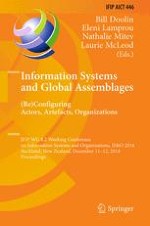2014 | Book
Information Systems and Global Assemblages. (Re)Configuring Actors, Artefacts, Organizations
IFIP WG 8.2 Working Conference on Information Systems and Organizations, IS&O 2014, Auckland, New Zealand, December 11-12, 2014. Proceedings
Editors: Bill Doolin, Eleni Lamprou, Nathalie Mitev, Laurie McLeod
Publisher: Springer Berlin Heidelberg
Book Series : IFIP Advances in Information and Communication Technology
